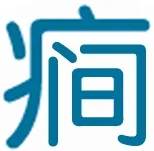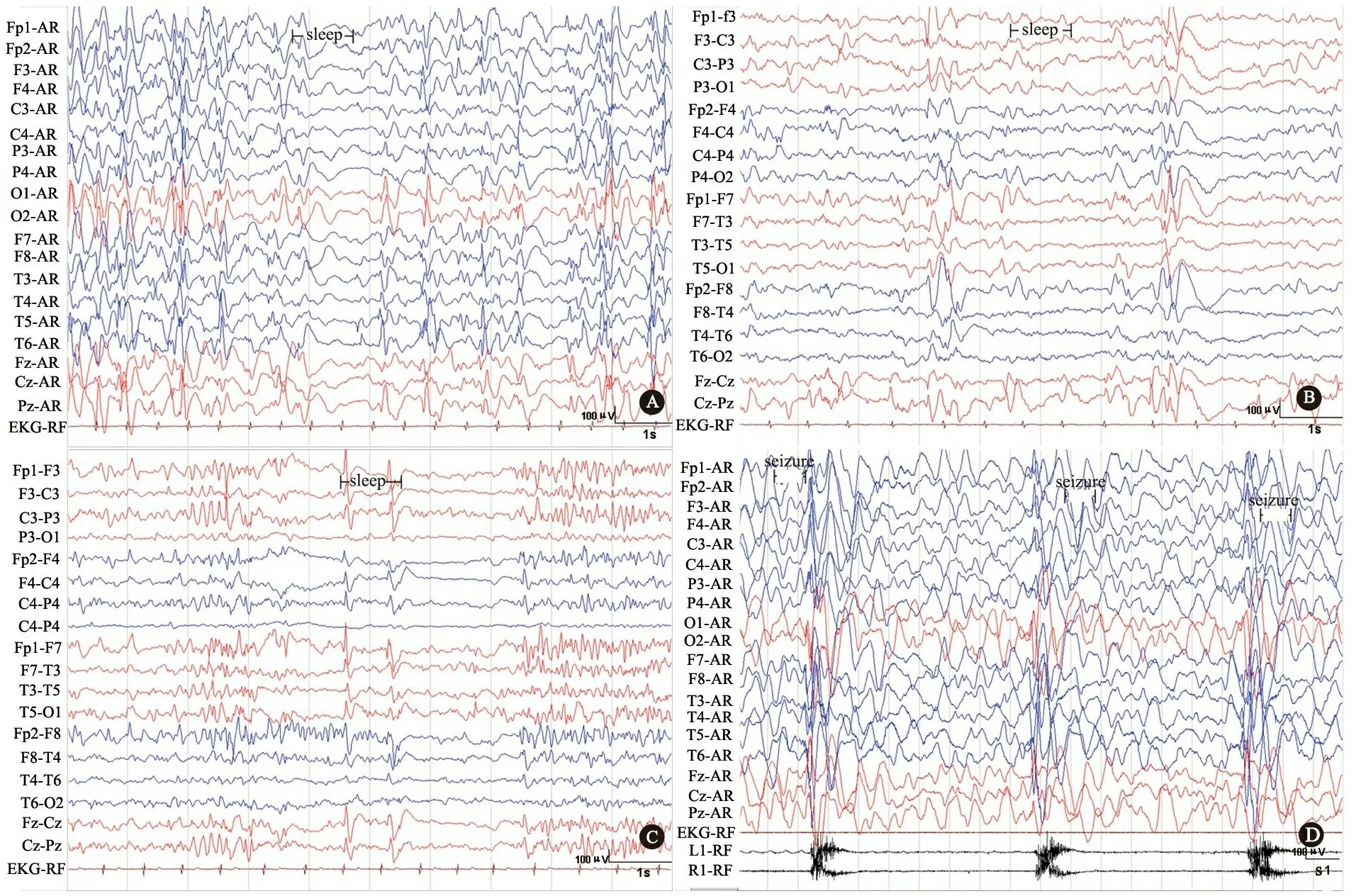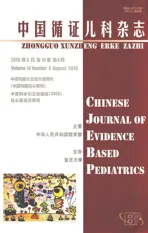晚发型癫性痉挛患儿临床特征及生酮饮食近期疗效分析
2015-04-22周渊峰龚晓妍周水珍柴毅明郁莉斐王新华卢忠英
周渊峰 龚晓妍 周水珍 王 艺 柴毅明 郁莉斐 王新华 卢忠英
·论著·

周渊峰1,3龚晓妍2,3周水珍1王 艺1柴毅明1郁莉斐1王新华1卢忠英2



1 方法

1.3 神经电生理检查 患儿入我院后常规行1~2次长程VEEG(意大利EB PLUS-32导视频脑电图系统)和同步肌电监测,监测时间>4 h,记录至少1个完整的清醒-睡眠周期。



2 结果

2.2.2 发作症状学特点 经VEEG监测到成串痉挛9例,孤立痉挛8例,成串和孤立痉挛1例。痉挛表现为屈曲型13例,伸展型2例,混合型1例,轻微痉挛(无明显躯干和肢体收缩)2例,其中合并强直痉挛3例;对称痉挛16例,不对称痉挛2例。同时还监测到全面性发作7例,其中不典型失神3例,强直发作和肌阵挛发作各2例;部分性发作3例。
2.3 神经电生理特点
2.3.1 发作间期神经电生理特点 18例患儿中EEG为典型高度失律4例(图1A);无典型高度失律14例,其中多灶和广泛性放电12例,一侧多灶放电2例。10例异常放电在颞区或颞额区明显(图1B),4例可见尖波或棘波节律(图1C)。

图1 晚发型癫性痉挛患儿发作间期和发作期EEG表现
Fig 1 Interictal and ictal EEG findings in late-onset epileptic spasm
Notes A: Interictal EEG showed hypsarrhythmia in a 2-year old male patient diagnosed as late-onset West syndrome; B: Interictal EEG showed multifocal discharges could be identified obviously in temporofrontal regions in an 8-year old male patient; C: Interictal EEG showed general spike wave rhythm in a 6-year old male patient diagnosed as Lennox-Gastaut syndrome; D: Ictal EEG showed clustered epileptic spasms in a 2-year old male patient diagnosed with late-onset West syndrome (L1R1, left and right deltoid muscle)
2.4 其他检查 18例均行头颅影像学检查,结构异常8例,其中脑多发软化灶5例,脑萎缩3例。10例行血、尿串联质谱检查,均未见明显异常。1例行ARX基因目标区域捕获二代测序,结果为阴性。
2.6 电-临床综合征分类 根据脑电图和临床表现,8例符合电-临床综合征诊断,其中晚发型West综合征4例,Lennox-Gastaut综合征4例。
3 讨论





[1]Goldstein J, Slomski J. Epileptic spasms: a variety of etiologies and associated syndromes. J Child Neurol, 2008, 23(4):407-414
[2]Lux AL, Osborne JP. A proposal for case definitions and outcome measures in studies of infantile spasms and West syndrome:consensus statement of the West Delphi group. Epilepsia, 2004, 45(11):1416-1428
[3]Engel J Jr. Report of the ILAE classification core group. Epilepsia, 2006, 47(9): 1558-1568
[4]Shinnar S. The new ILAE classification. Epilepsia, 2010, 51(4): 715-717
[5]Keene DL. A systematic review of the use of the ketogenic diet in childhood Epilepsy. Pediatr Neurol, 2006, 35(1): 1-5
[6]中华医学会儿科学分会神经学组生酮饮食疗法协作组. 长期生酮饮食治疗儿童难治性癫痫的前瞻性多中心研究. Chin J Pediatr(中华儿科杂志), 2013, 51(4):276-282
[7]Kwan P, Arzimanoglou A, Berg AT, et al. Definition of drug resistant epilepsy: Consensus proposal by the ad hoc Task Force of the ILAE Commission on Therapeutic Strategies. Epilepsia, 2010 ,51(6):1069-1077
[8]Zhou SZ(周水珍). 生酮饮食治疗儿童难治性癫. Chin J Appl Clin Pediatr(中华实用儿科临床杂志), 2013, 28(12): 883-885
[9]Suo C, Liao J, Lu X, et al. Efficacy and safety of the ketogenic diet in Chinese children. Seizure, 2013, 22(3): 174-178
[10]Eisermann MM, Ville D, Soufflet C, et al. Cryptogenic late-onset epileptic spasms: an overlooked syndrome of early childhood? Epilepsia,2006,47(6):1035-1042
[11]Pavone P, Striano P, Falsaperla R, et al. Infantile spasms syndrome, West syndrome and related phenotypes: What we know in 2013. Brain Dev,2014,36(9):739-751
[12]Hancock E, Osborne JP, Edwards SW, et al. Treatment of infantile spasms. Cochrane Database Syst Rev, 2013, 6:CD 001770
[13]Oguni H , Funatsuka M, Sasaki K, et al. Effect of ACTH therapy for epileptic spasms without hypsarrhythmia. Epilepsia, 2005, 46(5):709-715
[14]Hong AM, Turner Z, Hamdy RF, et al. Infantile spasms treated with the ketogenic diet: prospective single-center experience in 104 consecutive infants. Epilepsia, 2010, 51(8): 1403-1407
(本文编辑:张萍)
《新生儿临床决策手册》出版
《新生儿临床决策手册》已由人民卫生出版社出版发行。新生儿复苏流程图是一幅基于循证医学的指导新生儿复苏的标准化树状结构临床决策模式图,已在全世界推广使用,对新生儿复苏抢救的成功与否起到关键作用。与新生儿复苏类似,新生儿其他常见疾病的诊治流程也必须按照循证医学的要求进行标准化和优化。鉴于此目的,来自于复旦大学附属儿科医院4位年轻新生儿内外科专家(周文浩,程国强,王来拴,沈淳)总结自身的临床经验,综合北美几个主要新生儿重症监护病房中常见问题的处理规范,并结合中国的实际情况,采用循证医学的分析思路整理出《新生儿临床决策手册》一书。该书从新生儿最常见的症状入手,对每一系统的常见问题进行梳理编写,期望为年轻的新生儿专业医护人员提供一个较为系统的便于床旁使用的袖珍式决策手册。每册定价40元。欢迎广大儿科医生购买。
研究生教材《儿科学》出版
《儿科学》教材已于2014年7月由人民卫生出版社出版。本书由桂永浩、申昆玲教授主编。本教材编写通过提炼当今儿科领域的重大科学问题,选择重大有研究价值的临床问题,围绕以问题为核心进行编排,既有儿科领域全球关注的宏观问题,也有儿科学领域常见疾病发病机制以及诊疗方案的发展过程,对学科领域的研究热点及发展趋势进行评述和分析,并针对重要疾病的诊疗难点及进展进行详细介绍和展望,为研究生留出充分的批判性思考的空间,帮助研究生培养其创新思维能力,注重研究生提出问题、分析问题、解决问题能力的培养,使儿科研究生掌握儿科专业的重要进展和面临的问题。
本书编写人员均为中国儿科领域的知名学者,全书共16章,75万字,每册定价95元。欢迎广大学生及儿科临床医师选购。
Analysis of clinical features and the effect of ketogenic diet in children with late-onset epileptic spasms
ZHOUYuan-feng1,3,GONGXiao-yan2,3,ZHOUShui-zhen1,WANGYi1,CHAIYi-ming1,YULi-fei1,WANGXin-hua1,LUZhong-ying2
(1DepartmentofNeurology; 2DepartmentofClinicalNutrition,Children′sHospitalofFudanUniversity,Shanghai201102,China; 3Co-firstauthor)
ZHOU Shui-zhen,E-mail:szzhou@shmu.edu.cn
ObjectiveTo explore the clinical manifestations and electroencephalogram (EEG) features, causes and the effect of ketogenic diet (KD) for children diagnosed as pharmacoresistant late-onset epileptic spasms (LOES).MethodsThe clinical and EEG characteristics and the effect of antiepileptic drugs (AEDs) in 18 children with LOES were analyzed retrospectively. The effectiveness of one week, one month and three months after KD therapy for 8 children with pharmacoresistant LOES was evaluated. Results Eighteen children including 13 boys and 5 girls aged from 2 to 10 years with the median age of 6 years and 6 months were included. The onset age of epileptic seizures ranged from 1 year to 8 years with the median age of 3 years. The course of epilepsy ranged from 1 to 72 months with the median age of 9 months. The first seizure type was epileptic spasms in 4 cases and other seizure types in 14 children (77.8%). Interictal EEG showed classic hypsarrhythmia in 4 cases and no hypsarrhythmia in 14 cases (77.8%) of which multifocal discharges could be dentified obviously in temporofrontal regions. Developmental delay presented in all cases and 7 cases (44.4%) were symptomatic epilepsies, of which the commonest causes were central nervous system infection and perinatal insults, while 11 cases (61.1%) had unknown causes. Four patients fulfilled the entry criteria of late-onset West syndrome and 4 patients were diagnosed as Lennox-Gastaut syndrome. Eighteen patients were followed up for 3 to 24 months during AEDs treatment and the majority of the children were on valproate in monotherapy (n=2) or in combination with other AEDs (n=16) at the last follow up. Fourteen patients (77.8%) were diagnosed with pharmacoresistant epilepsy and 8 cases of them received KD therapy. Greater than 50% seizure reduction was achieved in 2 of 8 cases at one week, 3 of 8 cases at 1 month and 5 cases (62.5%) at 3 months after KD therapy. Seizure free was achieved in 1 of 8 case at one month and 3 cases (37.5%) at 3 months after KD therapy. Eight patients treated with KD was well tolerated and adverse effects were not found.ConclusionChildren with LOES not only occur in West syndrome, but also in other epileptic encephalopathy. Interictal EEG does not show classic hypsarrhythmia in most patients generally. Most LOES are refractory epilepsy and the KD is a safe and potentially effective method of treatment for children with LEOS.
Children; Epileptic spasms; Video electroencephalogram; Ketogenic diet
复旦大学附属儿科医院 1 神经科,2 临床营养科 上海,201102;3 共同第一作者
周水珍,E-mail:szzhou@shmu.edu.cn
10.3969/j.issn.1673-5501.2015.04.010
2015-05-06
2015-07-25)
